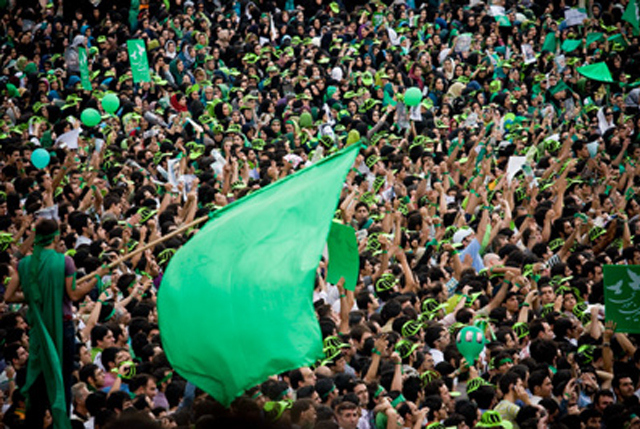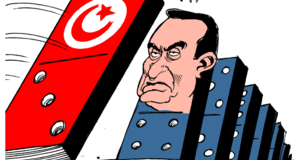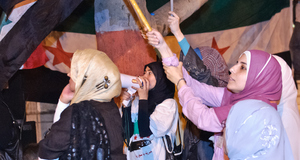From Cornell International Affairs Review VOL. 5 NO. 1The Evolution of Revolution: Social Media in the Modern Middle East and its Policy Implications
IN THIS ARTICLE
KEYWORDS
Wael Ghonim, a 30-year-old Egyptian who works as an executive for Google, enjoyed a house in the United Arab Emirates with a pool and a nice car. But when news of the Egyptian protests reached him in January 2011, he anonymously started a Facebook page supporting a martyred dissident and traveled back to Cairo. The 500,000 member Facebook group “We are all Khalid Said” became a virtual rallying point. Protests were organized on the site, and posts exposed police brutality in graphic pictures and descriptions. Days later he was in an Egyptian prison, a casualty of a 30-year-old emergency law that allowed the government to arrest and detain him without charge. Ghonim’s disappearance sparked a massive campaign against the Mubarak regime to release him, spearheaded by his employer, the United States, and the rage of the Egyptian street. Hours after his release from days of torture and captivity, Ghonim appeared on Egyptian TV in front of tens of millions of his countrymen. His tears and impassioned pleas for the overthrow of the regime and the creation of a new Egypt revitalized the masses to continue protesting. He said later, “If you want to liberate a society, just give them the internet.”1 Cyber-pessimistic scholars like Evgeny Morozov and Malcolm Gladwell dispute the notion that social media is a “magic pill” for the subjugated in the Middle East. Says Morozov, “The idea that the internet favors the oppressed rather than the oppressor is marred by what I call cyber-utopianism: a naïve belief in the emanicipatory nature of online communication that rests on a stubborn refusal to admit its downside.”2 Still, scholars and politicos like Clay Shirky and Nicholas Kristof suggest otherwise. Condoleezza Rice trumpeted the internet’s utility as a tool for the oppressed, saying “the internet is possibly one of the greatest tools for democratization and individual freedom that we’ve ever seen.”3 Is social media democratizing by nature? How do cultural, social, and structural factors impact its potential influence? And finally, to what extent is the phenomenon responsible for the Middle Eastern uprisings? The social media umbrella, which encompasses mobile texting, e-mail, social networking, and photo and video-sharing, certainly plays a role in disseminating information, galvanizing support, and organizing protests.4 But how does one determine the nature, degree, and extent of its role in political dissidence? Whether it is used to incite unrest or promote democracy, social media is a superior tool for political dissidence precisely because it was not engineered for any particular narrow focus. This paper will draw parallels between the availability of social media and its potential for political dissidence. It will show that despite popular belief, social media is not inherently democratizing. It will delineate how Lessig’s Framework of Regulation can compare the varying degrees of social media in the Middle East. Finally, it will argue that social media is not a prerequisite to revolution but rather an accelerant to the process of political dissent. Social Media: A Dissident’s Dream?Specifically, what is the relationship between social media and political dissidence? Why did the Egyptian state, which received $1.3 billion in military aid from the U.S. in 2010, feel it was necessary to kidnap a Google executive during protests? What is it about text messages, e-mail, and sites like YouTube and Twitter that scare long-standing authoritarian regimes? Social media allows people to contribute to a virtual public discourse that they would otherwise not be able to take part in. Cyberspace and mobile networks form a gateway to a virtual world removed from police brutality, hierarchies, and corrupt representation. This is a virtual world where the best ideas resonate without regard for the identity of the author. The male-dominated Middle East demonstrates the disparity between the physical and virtual. While women are restricted from joining the political chatter of the neighborhood water-pipe lounge, they are taking more liberties online. “They cannot go to the park unaccompanied and meet friends, but they can join a chat room or send instant messages,” a member of a Jordanian-based social media group explains.5 Social norms and customs are less of a hindrance with speech on the internet, and people that previously lacked a voice are finding access to one online. Social media provides real-time information, up-to-date and unmolested, unlike Arab state television and government propaganda. Freedom of the internet means that people choose their sources, and those reputed as trustworthy rise to the top. Egyptian, Tunisian, Libyan, and Syrian authoritarians tried to cow citizens by alleging that foreign conspiracy fueled the revolutionary fire. Due to access to independent news, many came to view these tactics as less credible. A freer internet exposes this propaganda by allowing for a meritocracy of ideas in a public discourse. However, proliferation of information via social media does not allow for content control that traditional media outlets have. Consequently, the same tool that brings freedom and democracy can also be wielded to misinform. This real-time knowledge beguiles bogus claims, but can also cause hysteria and panic. Images of the Danish cartoon and news of the Quran-burning controversy that incited thousands to riot and kill across the Muslim world would not have spread as fast and as far in a world without social media. Whether it is used to incite unrest or promote democracy, social media is a superior tool for political dissidence precisely because it was not engineered for any particular narrow focus. Its multifaceted nature means people who contribute to political dissidence blend in with those who use it to post photos, gossip, and keep in contact with friends and family. The ubiquity of social media among many types of users means that governments cannot pinpoint individual dissidents as easily. Comparatively, as Clay Shirky argues, specialized encryption software specifically designed for dissident groups can be exposed by authoritarian government intelligence agencies.6 In addition to providing a private way for citizens to communicate amongst themselves, social media is used to organize, galvanize support, and promote causes of all kinds, politically motivated or not. A popular sociological theory explains the formation of an opinion in two integral steps. First, viewpoints are transmitted by television and other forms of media. Opinions are formed in the second step, when family, friends, and acquaintances reiterate these viewpoints.7 Social media is a virtual replication of this process; in a sense, it is an “echo box.” Social Media: Inherently Democratic?Some experts believe fervently in Christopher Kedzie’s dictator’s dilemma theory (1997). With the existence of unchecked forums for public discourse, an autocratic state faces a dilemma: to censor dissidence or fight back with propaganda. Both choices run the risk of radicalizing citizens. According to the dictator’s dilemma, Egypt’s shutdown of mobile and internet networks during the protests in February 2011 risked alienating otherwise pro-Mubarak citizens whose communications were interrupted at a time of crisis. Likewise, the U.A.E and Saudi Arabia angered citizens in 2010 when they banned Blackberry phones for fear that dissident groups were using the popular Messenger feature to communicate while avoiding prying eyes. This decision also caused collateral damage, inconveniencing many more legal users than illegal users, offering a perfect example of the dictator’s dilemma. Thus, the theory posits that the mere presence of social media confronts regimes with hard choices, most of which lead to increased freedom of communication and political dissent. Though a compelling argument, the dictator’s dilemma theory overlooks many factors. The existence of social media is not a guarantee that a disgruntled population will unite or democratize at all. More separate and systemic environmental realities help political dissent transition into organized revolution, and these can explain why some countries in the Middle East face more serious threats to the established order than others. Population density and homogeneity are extremely telling demographic factors helpful in enabling revolutionaries to coalesce. Take Egypt, Tunisia, and Libya as examples of the Middle Eastern countries that have faced the most serious changes in the political status quo. In Egypt, the Nile functions as the lifeblood of a country that is overwhelmingly desert and mountains. The consequence is a situation in which 95 percent of Egyptians live on less than four percent of its land. Tunisia and Libya are similar. Sixty-seven percent of Tunisians and 78 percent of Libyans live in populous cities near the coast.8 9 An ethnically homogenous country like Egypt (99.6 percent Egyptian) saw regime change become a reality in a matter of days.10 Tribal Libya took months, even with NATO help, to finally overcome loyal Qaddafi militias. Meanwhile Bahrain’s protests failed; the lack of religious homogeneity certainly did not help create an incentive for members of the Sunni ruling class to defect to the Shi’a majority’s side. Even when protesters coalesce, demands are met, and dictators are dead or deposed, democracy is not concrete inevitability. Popular revolutions have happened before and failed. In Iran in 1979, a popular revolution was an excuse for a power-hungry mullah to wrest authoritarian control from the Shah. In Tunisia and Egypt, remnants of the former ruling parties are still trying to use their structural advantage to take representation away from upstart democratic parties. Conditions like population density and homogeneity are factors that correlate with successful revolutions. These affect social media’s ability to be a potent accelerant to revolution. Therefore, it is premature to assume that the political dissent fostered by social media alone will automatically translate to freedom and democracy in the Middle East.Continued on Next Page » Suggested Reading from Inquiries Journal
Inquiries Journal provides undergraduate and graduate students around the world a platform for the wide dissemination of academic work over a range of core disciplines. Representing the work of students from hundreds of institutions around the globe, Inquiries Journal's large database of academic articles is completely free. Learn more | Blog | Submit Latest in Political Science |





















